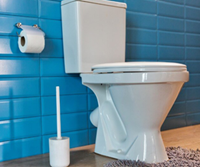Laundry
Did you know that 15-20% of water used in your home is in the laundry?
Washing machine tips
- To save water and energy, always run your washing machine on a full load. You'll save 10 litres of water each wash!
- If you do need to wash before the machine is full, adjust the water level to suit the size of the wash load - some new water efficient models will do this automatically.
- Wash in cold water if you can - you'll use less energy and may get just as good a wash
- Check for water efficiency - look for washing machines that have a four or more WELS star rating (more info below on how to chose a washing machine). Front loading washing machines are more water and energy efficient.
- Use the sud-saver option if your machine has one, if you have several loads to wash.
- Pre-treat stains before you load clothes into your machine to save having to wash again.
By law, all washing machines must carry a label which gives a star rating for the machine's water efficiency. The more stars, the less water the machine uses per wash. The label also provides water consumption in litres for each cold and warm wash. The Water Efficiency Labelling and Standards (WELS) Scheme has a rinse performance test built into the rating, so you know your clothes will come out clean.
All machines will also display a label for energy efficiency. The most stars displayed, the less energy the machine uses. Energy consumption figures may also be provided for warm and cold wash.
To minimise your total running costs, select a model within your budget that is high in both water and energy efficiency.
Choosing a washing machine
Choosing a washing machine can be confusing and most of us don't think of it until our machine breaks down. If you're in the market for a new machine check out these tips below to help you make the right choice.
Front loader or top loader?
Front loading washing machines have an opening on the front of the machine, where clothes can be loaded and unloaded. All dials and buttons are typically located on the front. Top loading washing machines open from the top of the machine, where clothes can be loaded and unloaded. The dials and buttons are typically found on top, along the back edge of the machine. Deciding which is best is a matter of personal choice, although there are a number of pros and cons that should be considered.
On water use alone, front loaders come out in front, using up to up to 70% less water in some cases!
If you want to buy a top loader and still save water, look for a model with at least 3 water efficiency stars and an adjustable water level. This will help you to reduce the water used with smaller loads.
The Pros and Cons
How's it going to perform?
Front loaders typically rank better than top loaders in terms of performance.
How's it going to wash?
Front loaders are gentler on the clothes than top loaders. They have higher spin speeds resulting in less moisture in the clothes on completion. This shortens drying time and minimises use of a tumble dryer. In terms of dirt removal or rinse performance, neither type has an advantage, but front loaders offer more temperature and wash options.
I want to save water and energy
One of the biggest advantages of front loaders is that they use less water than top loaders, up to 70% less in some cases or 36,000 litres per year for a typical household. They also use less detergents and less energy if you wash with warm or hot water. This reduces greenhouse gases making front loaders more environmentally friendly than top loaders.
How easy is it to load washing?
Front loaders on the floor require bending to load and unload, unlike top loaders which could cause problems for those with back problems. However, these problems are reduced if front loaders are placed on pedestals or a purpose built cabinet.
Saving space
Front loaders are very effective space savers. A dryer can easily be mounted on top of the machine without interfering with its operation.
Can I add clothes after turning the machine on?
Most front loaders cannot be opened once the cycle starts. However, some newer models are able to overcome this problem. Washing can be added to top loaders at any point of the cycle.
How long does it take to wash?
Front loaders generally take longer to complete a cycle than top loaders, sometimes up to 40 minutes more.
Other ways to save in the laundry
Of course, saving water in the laundry can also be achieved by installing water efficient taps and fixing any leaks. Check out our Taps and Leaks sections for advice.
Save water in other areas of your home:
Toilets | Bathroom | Taps |




